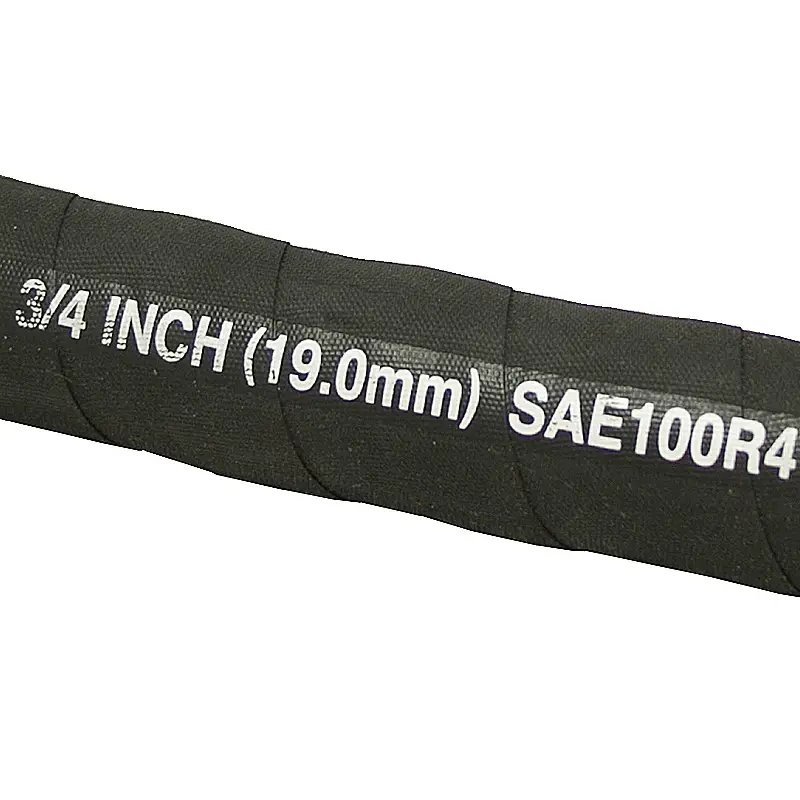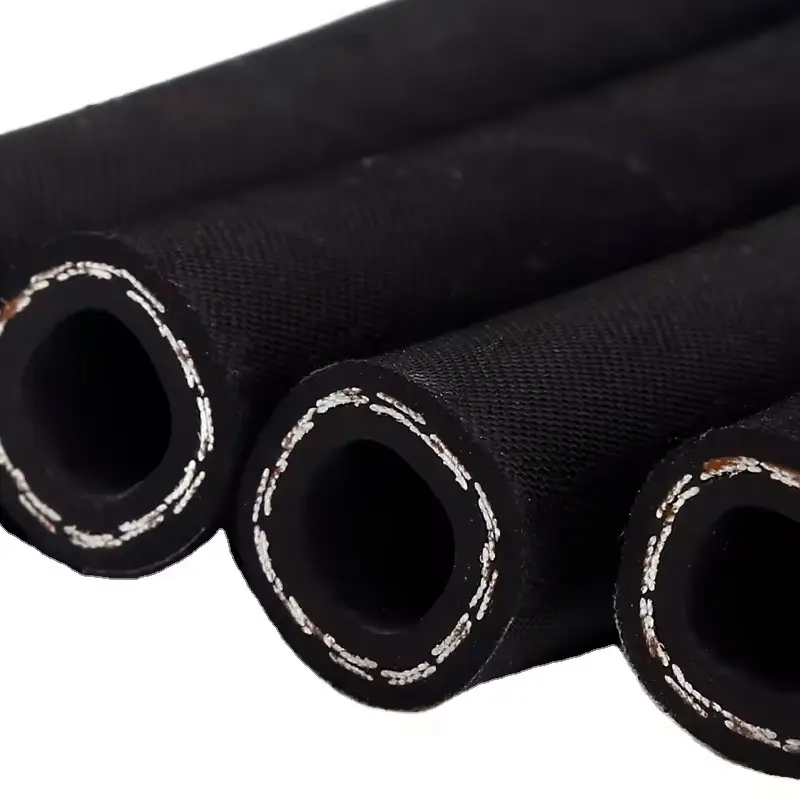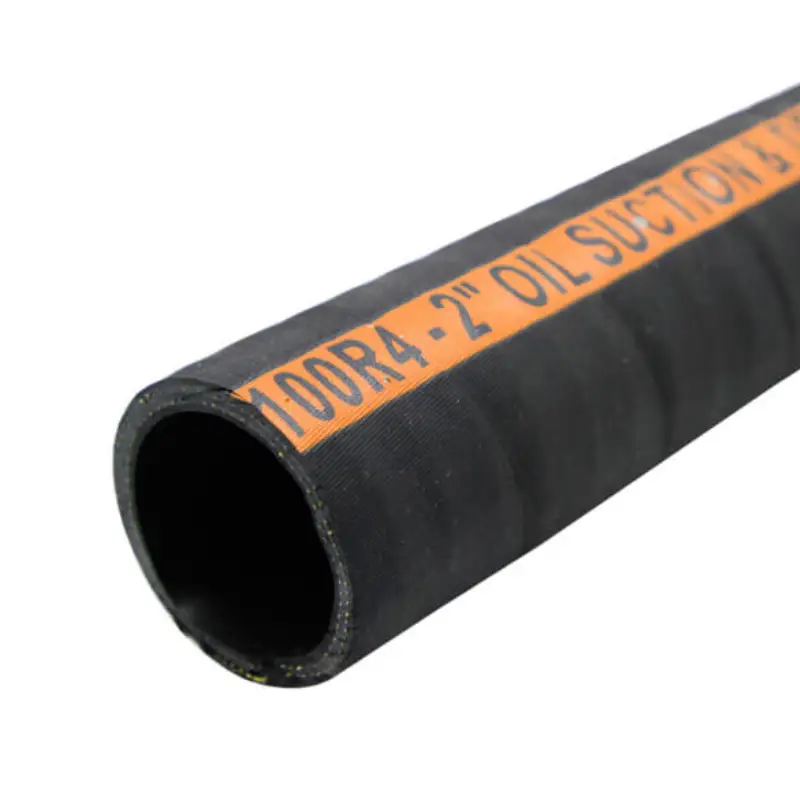Kingdaflex offers premium 3/4 inch hydraulic hose, engineered for superior performance in demanding applications. Our hoses provide exceptional durability and reliability for fluid transfer in industrial, mobile, and agricultural systems. Crafted with high-quality materials, they withstand high pressures and harsh conditions, ensuring long-lasting service. Trust Kingdaflex for robust and efficient hydraulic solutions.
High-Pressure Capability – Engineered to withstand demanding hydraulic pressures. Our hoses maintain structural integrity under extreme conditions, providing leak-free performance and reliable fluid transmission for various systems.
Durable Construction – Made with reinforced synthetic rubber and steel braid layers. This design ensures long-lasting service, resists wear, abrasion, and environmental damage, and reduces system maintenance requirements.
Flexible and Easy to Install – 3/4-inch hoses are designed for smooth bending and routing. They allow easy installation in tight spaces while maintaining performance and preventing kinking or damage.
We engineer our 3/4 inch hydraulic hoses for maximum durability, utilizing high-grade synthetic rubber, reinforced with multiple layers of high-tensile steel wire. This robust construction ensures exceptional resistance to abrasion, ozone, and various chemicals, extending the hose’s lifespan even in the most challenging environments. You can count on our materials to withstand the test of time.
We understand that ease of installation is crucial. Our 3/4 inch hydraulic hoses offer excellent flexibility, allowing for easier routing and installation in complex machinery and tight spaces. Despite their robust construction, they maintain a manageable bend radius, reducing the likelihood of kinking and ensuring a smooth, uninterrupted flow of hydraulic fluid.
Our 3/4 inch hydraulic hoses are designed to handle a wide range of pressure requirements, from medium to extremely high pressures. We meticulously test each hose to guarantee consistent performance and safety under operational stress, preventing bursts and leaks. This commitment to superior pressure ratings ensures reliable and efficient fluid transfer for your critical applications.
The versatility of our 3/4 inch hydraulic hoses makes them suitable for a vast array of applications. We see them extensively used in heavy machinery, construction equipment, agricultural implements, and industrial hydraulic systems. Their reliable performance across diverse sectors highlights our commitment to providing adaptable and high-quality solutions for your specific needs.

At Kingdaflex, we supply top-quality 3/4 inch hydraulic hoses designed for optimal performance and longevity. Our hoses are meticulously crafted to meet rigorous industry standards, ensuring reliable fluid transfer in various high-pressure applications. We offer a comprehensive range that withstands demanding conditions, providing the durability and flexibility your operations require. Trust Kingdaflex to provide robust hydraulic solutions for your needs.

Kingdaflex supplies premium 3/4 inch high pressure hydraulic hoses, engineered for peak performance in demanding environments. Our hoses deliver exceptional durability and reliability for critical fluid transfer in industrial, mobile, and agricultural systems. We craft them with superior materials to withstand extreme pressures and harsh conditions, ensuring long-lasting, efficient service. Choose Kingdaflex for dependable hydraulic solutions.

Kingdaflex provides reliable 3/4 inch return hydraulic hoses, designed for efficient low-pressure fluid return in various systems. Our hoses offer excellent flexibility and chemical resistance, making them ideal for a wide range of industrial, mobile, and agricultural applications. We ensure durable construction for long-lasting performance, supporting the smooth operation of your hydraulic systems. Trust Kingdaflex for quality return line solutions.

Kingdaflex provides reliable 3/4 inch suction hydraulic hoses, designed for efficient fluid intake in various applications. Our hoses offer excellent flexibility and durability, resisting collapse under vacuum conditions. We craft them to handle a wide range of media, ensuring consistent performance in agricultural, industrial, and mobile equipment. Trust Kingdaflex for high-quality, dependable suction hose solutions.

We offer 3/4-inch 2-wire hydraulic hoses designed for high-pressure hydraulic systems. Reinforced with two braided steel wire layers, our hoses provide exceptional strength, flexibility, and durability. Ideal for industrial, mobile, and agricultural applications, they ensure leak-free performance, smooth fluid transfer, and long-lasting reliability in demanding hydraulic environments.

We offer 3/4″ low-pressure hydraulic hoses, designed for reliable fluid transfer in industrial and mobile applications. Our hoses ensure flexibility, durability, and resistance to abrasion, oil, and weathering. Perfect for light hydraulic systems, these hoses deliver consistent performance under low-pressure conditions, keeping your operations smooth and efficient while minimizing maintenance needs.

We offer premium 3/4 hydraulic air hoses designed for durability, flexibility, and high-pressure performance. Perfect for industrial, construction, and automotive applications, our hoses ensure reliable air and fluid transfer. Built with reinforced layers, they resist abrasion, kinking, and extreme temperatures. Choose our hoses for efficiency, safety, and long-lasting operation in demanding environments.
The flow rate of a 3/4 inch hydraulic hose is a critical factor in hydraulic system design, influencing efficiency, pressure drop, and heat generation.
While a general range for a 3/4 inch hydraulic hose might be around 20-30 GPM (gallons per minute), the exact flow rate depends on several interacting factors.
It’s important to select a hydraulic hose size that allows for optimal fluid velocity to avoid issues like excessive heat, pressure loss, and damage to components.
Here are the key factors affecting the flow rate in a 3/4 inch hydraulic hose:
Internal Diameter (ID) of the Hydraulic Hose: This is the most direct factor. While it’s a “3/4 inch” hydraulic hose, the actual internal diameter can vary slightly between manufacturers and hose types. A larger ID allows for a higher volume of fluid to pass through at a given velocity.
Fluid Velocity: This refers to how fast the hydraulic fluid is moving through the hose. Higher velocities increase the flow rate, but also increase friction and potential for turbulence, leading to greater pressure drop and heat. Recommended velocities vary depending on the line type (suction, pressure, return).
System Pressure: Higher system pressures can influence flow by potentially increasing fluid density slightly, but more significantly, higher pressures often require hoses with thicker walls, which can slightly reduce the internal diameter for a given nominal size, thus impacting flow.
Fluid Viscosity and Temperature: Thicker (higher viscosity) fluids will flow more slowly than thinner fluids at the same pressure, leading to a lower flow rate. Temperature directly affects fluid viscosity; as temperature increases, viscosity typically decreases, allowing for higher flow rates.
Hose Length and Bends: Longer hydraulic hoses and hoses with more bends or tight turns increase frictional resistance, which contributes to pressure drop and reduces the effective flow rate. Each bend creates a restriction that the fluid must overcome.
Fittings and Connectors: The type and design of fittings and connectors used with the hose can also impact flow rate. Restrictive fittings can create additional pressure drops, limiting the overall flow.
When measuring hydraulic hose diameters, accuracy is paramount to ensure proper system performance and safety. There are typically two key measurements: Inner Diameter (ID) and Outer Diameter (OD).
Here’s how to approach each, along with tools and important considerations.
The inner diameter (ID) is arguably the most crucial measurement for a hydraulic hose, as it directly impacts the fluid flow rate, velocity, and potential for pressure drops or excessive heat generation. To measure the ID, you will need a caliper (vernier or digital) or a specialized ID gauge. Carefully insert the inside jaws of the caliper into the hose opening, ensuring they are perpendicular to the hose walls.
Gently expand the jaws until they make firm, but not forceful, contact with the inner walls of the hose. Read and record the measurement from the caliper’s scale. It is always a good practice to take multiple measurements at different points along the hose end to account for any slight manufacturing variations or potential deformation.
The outer diameter (OD) of a hydraulic hose is important for fitting compatibility, clamp selection, and routing the hose in confined spaces within a machine or system. For this measurement, you will use the outside jaws of a caliper. Position the jaws around the outer surface of the hose at its widest point.
Close the caliper until it lightly touches both outer walls, ensuring it is perpendicular to the hose’s axis. Record the measurement. For very large diameter hoses where a caliper might not be sufficient, you can use a flexible measuring tape to determine the circumference and then divide by Pi (π≈3.14159) to calculate the OD.
Many hydraulic hoses are also designated by “dash sizes,” which are an industry standard corresponding to the hose’s inner diameter in sixteenths of an inch.
For instance, a “-08” hose signifies an inner diameter of 8/16 inches, which simplifies to 1/2 inch. While direct measurement is valuable, understanding the dash size system can help in cross-referencing with manufacturer specifications and ensuring you select the correct replacement hose. This system simplifies ordering and standardization within the hydraulic industry.
Choosing the right hydraulic hose size is critical for the efficiency, safety, and longevity of your hydraulic system. An undersized hose can lead to excessive fluid velocity, resulting in increased friction, higher temperatures, significant pressure drops, and even premature hose failure or damage to other system components like pumps and valves.
Conversely, an oversized hose can result in sluggish system performance and may be more difficult or costly to route and install. The goal is to find the optimal balance that allows for efficient fluid transfer while minimizing energy loss and maximizing component lifespan.
Here are key factors to consider when selecting hydraulic hose sizes:
Flow Rate (GPM or LPM): This is the volume of hydraulic fluid moving through the hose per unit of time. It’s the primary determinant of the required inner diameter (ID). The hose’s ID must be large enough to accommodate the maximum flow rate of your system without generating excessive fluid velocity.
Fluid Velocity (ft/sec or m/sec): This is the speed at which the fluid travels through the hose. Each type of line (suction, pressure, return) has recommended maximum fluid velocities to ensure laminar flow and minimize turbulence, which can cause heat and pressure loss. For instance, suction lines typically require lower velocities to prevent pump cavitation.
System Pressure (PSI or Bar): While not directly determining the ID, the maximum working pressure of your system is crucial for selecting a hose that can safely withstand the forces involved. Hoses with higher pressure ratings often have thicker walls or more reinforcement layers, which can impact the overall outer diameter (OD) and flexibility. Always ensure the hose’s working pressure rating meets or exceeds the system’s maximum operating pressure, including any potential surge pressures.
Fluid Type and Temperature: The type of hydraulic fluid (e.g., petroleum-based, water-glycol) and its operating temperature range affect the hose material compatibility and its ability to maintain integrity under thermal stress. Higher temperatures can reduce a hose’s pressure rating and shorten its lifespan.
Hose Length and Bend Radius: Longer hoses inherently cause more pressure drop due to increased friction. Similarly, tight bends (smaller bend radius) can restrict flow, generate heat, and put stress on the hose, leading to premature failure. Always consider the minimum bend radius specified by the manufacturer for the hose.
Environmental Conditions: External factors such as abrasion, exposure to chemicals, UV radiation, or extreme ambient temperatures can influence the choice of hose cover material and overall construction, which might subtly affect the OD or flexibility.
Fittings and Connectors: The selected hose size must be compatible with the fittings and connectors used in your system to ensure a secure, leak-free connection. Manufacturers’ specifications for both hoses and fittings should always be consulted for compatibility.
Dash Size System: Hydraulic hoses are often identified by “dash sizes,” which typically refer to the hose’s inner diameter in sixteenths of an inch (e.g., -8 indicates an 8/16″ or 1/2″ ID). Understanding this industry standard helps in quickly identifying and replacing hoses.